Peeking into Apache Flink's Engine Room
http://flink.apache.org/news/2015/03/13/peeking-into-Apache-Flinks-Engine-Room.html
Join Processing in Apache Flink
In this blog post, we cut through Apache Flink’s layered architecture and take a look at its internals with a focus on how it handles joins. Specifically, I will
- show how easy it is to join data sets using Flink’s fluent APIs,
- discuss basic distributed join strategies, Flink’s join implementations, and its memory management,
- talk about Flink’s optimizer that automatically chooses join strategies,
- show some performance numbers for joining data sets of different sizes, and finally
- briefly discuss joining of co-located and pre-sorted data sets
这篇blog会从flink内部详细看看是如何处理join的,尤其,
如何用Flink API,简单的实现join
讨论基本的join策略,flink join的实现和内存管理
讨论flink的优化器,如何自动选择join策略
显示不同数据size上的性能数据,
最后简单讨论一下co-located和预排序的数据集的join问题
How do I join with Flink?
Flink provides fluent APIs in Java and Scala to write data flow programs.
// define your data types
case class PageVisit(url: String, ip: String, userId: Long)
case class User(id: Long, name: String, email: String, country: String) // get your data from somewhere
val visits: DataSet[PageVisit] = ...
val users: DataSet[User] = ... // filter the users data set
val germanUsers = users.filter((u) => u.country.equals("de"))
// join data sets
val germanVisits: DataSet[(PageVisit, User)] =
// equi-join condition (PageVisit.userId = User.id)
visits.join(germanUsers).where("userId").equalTo("id")
可以看到用flink api实现join还是比较简单的
How does Flink join my data?
Flink如何做join,分两个阶段,
Ship Strategy
Local Strategy
Ship Strategy
对于分布式数据,数据是散落在各个partition中的,要做join,首先要把相同join key的数据放到一起,这个过程称为Ship Strategy
Flink的Ship Strategy有两种,
Repartition-Repartition strategy (RR)
The Repartition-Repartition strategy partitions both inputs, R and S, on their join key attributes using the same partitioning function.
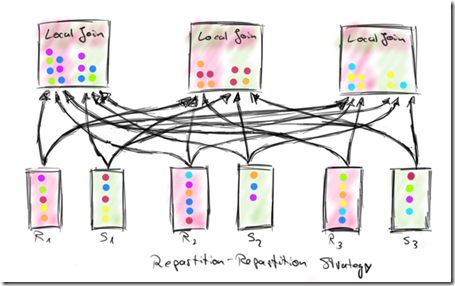
比如,R,S做join,我们就用一个相同partition函数,按join key,把R,S的所有分区,shuffle到3个local join上
这样做需要把full shuffle of both data sets over the network
Broadcast-Forward strategy (BF)
The Broadcast-Forward strategy sends one complete data set (R) to each parallel instance that holds a partition of the other data set (S)
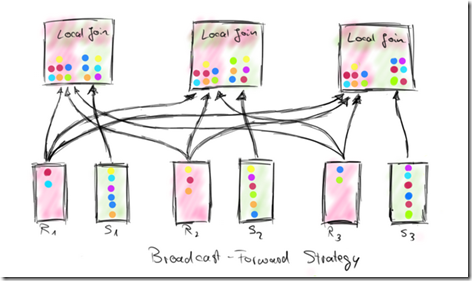
S不动,把R广播到所有的join实例上;显然如果R足够小,这样做是很有效的
Flink’s Memory Management
对join的场景,很容易想到,在ship阶段,需要shuffle大量的数据,内存是否会OutOfMemoryException,或是否会发生full gc
Flink handles this challenge by actively managing its memory.
When a worker node (TaskManager) is started, it allocates a fixed portion (70% by default) of the JVM’s heap memory that is available after initialization as 32KB byte arrays.
This design has several nice properties.
First, the number of data objects on the JVM heap is much lower resulting in less garbage collection pressure.
Second, objects on the heap have a certain space overhead and the binary representation is more compact. Especially data sets of many small elements benefit from that.
Third, an algorithm knows exactly when the input data exceeds its working memory and can react by writing some of its filled byte arrays to the worker’s local filesystem. After the content of a byte array is written to disk, it can be reused to process more data. Reading data back into memory is as simple as reading the binary data from the local filesystem.
The following figure illustrates Flink’s memory management.
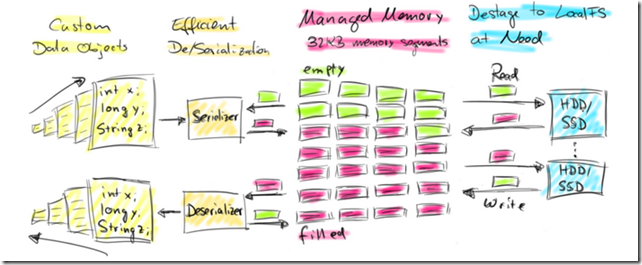
Flink是主动管理JVM的heap内存的,会申请一组32KB的memory segments,给各种算法用
好处就是,这样减少GC的压力;而且数据是序列化成binary后存储,overhead很小;自己管理内存,内存不够的时候,可以知道并写磁盘文件
Local Strategies
After the data has been distributed across all parallel join instances using either a Repartition-Repartition or Broadcast-Forward ship strategy, each instance runs a local join algorithm to join the elements of its local partition.
Flink’s runtime features two common join strategies to perform these local joins:
- the Sort-Merge-Join strategy (SM) and
- the Hybrid-Hash-Join strategy (HH).
在ship strategy,我们已经把相同join key的数据,放到同一个local partition上,现在要做的只是run一个local join算法
Flink有两种local join算法,
The Sort-Merge-Join works by first sorting both input data sets on their join key attributes (Sort Phase) and merging the sorted data sets as a second step (Merge Phase).
The sort is done in-memory if the local partition of a data set is small enough.
Otherwise, an external merge-sort is done by collecting data until the working memory is filled, sorting it, writing the sorted data to the local filesystem, and starting over by filling the working memory again with more incoming data. After all input data has been received, sorted, and written as sorted runs to the local file system, a fully sorted stream can be obtained. This is done by reading the partially sorted runs from the local filesystem and sort-merging the records on the fly. Once the sorted streams of both inputs are available, both streams are sequentially read and merge-joined in a zig-zag fashion by comparing the sorted join key attributes, building join element pairs for matching keys, and advancing the sorted stream with the lower join key. The figure below shows how the Sort-Merge-Join strategy works.
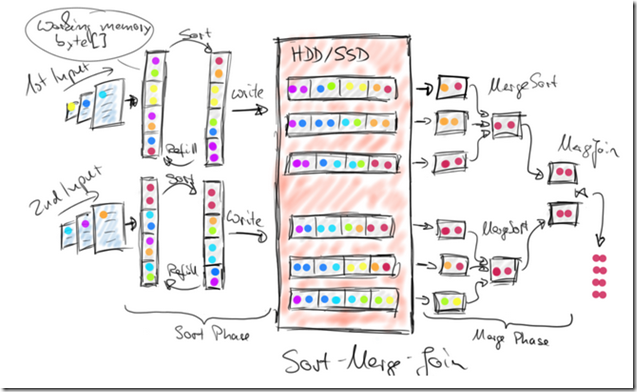
这个算法,如其名,两个过程,sort,merge
首先是,sort,如果数据足够小,在内存中直接sort,这个比较简单
如果数据比较大,需要用到外排算法,比如内存可以排序1G数据,而我有3G数据,那就每次只读1G,排序,存入一个文件,这样最终会产生3个已局部排序的文件,如图
读的时候,同时打开3个文件,边读边merge就可以产生一个全局有序的stream
然后是,merge,对于两个已排序的inputs,做join很简单
The Hybrid-Hash-Join distinguishes its inputs as build-side and probe-side input and works in two phases, a build phase followed by a probe phase.
In the build phase, the algorithm reads the build-side input and inserts all data elements into an in-memory hash table indexed by their join key attributes. If the hash table outgrows the algorithm’s working memory, parts of the hash table (ranges of hash indexes) are written to the local filesystem. The build phase ends after the build-side input has been fully consumed.
In the probe phase, the algorithm reads the probe-side input and probes the hash table for each element using its join key attribute. If the element falls into a hash index range that was spilled to disk, the element is also written to disk. Otherwise, the element is immediately joined with all matching elements from the hash table. If the hash table completely fits into the working memory, the join is finished after the probe-side input has been fully consumed. Otherwise, the current hash table is dropped and a new hash table is built using spilled parts of the build-side input.
This hash table is probed by the corresponding parts of the spilled probe-side input. Eventually, all data is joined. Hybrid-Hash-Joins perform best if the hash table completely fits into the working memory because an arbitrarily large the probe-side input can be processed on-the-fly without materializing it. However even if build-side input does not fit into memory, the the Hybrid-Hash-Join has very nice properties. In this case, in-memory processing is partially preserved and only a fraction of the build-side and probe-side data needs to be written to and read from the local filesystem. The next figure illustrates how the Hybrid-Hash-Join works.
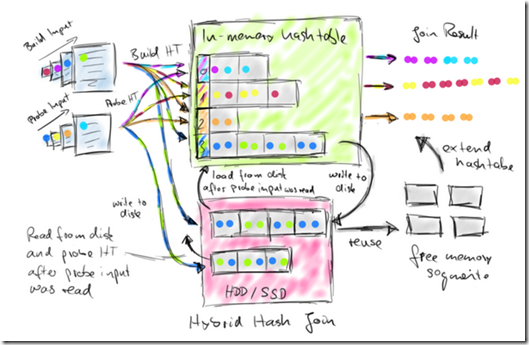
这个算法会把两个input,分成bulid input和probe input
其中build input会用于以join key来build一个hash table,如果这个hash table足够小,那么很简单
当build完hash table后,我们只需要遍历probe input,如果落在hash table中,就做join
这个方法,如果build input足够小,会非常高效,因为我们不需要在内存中存probe input,只需要读一条处理一条即可
但如果build input比较大,内存放不下整个hash table怎么办?
也很简单,内存不够的时候,把部分hash table,以hash index range,存入磁盘
这样当遍历probe input的时候,如果对应的hash table在磁盘,那么暂时把这部分probe input也存入磁盘
最后,当遍历完probe input后,内存中的hash table已经完成join,删掉,载入磁盘中的hash table完成最后的join
How does Flink choose join strategies?
Ship and local strategies do not depend on each other and can be independently chosen.
Therefore, Flink can execute a join of two data sets R and S in nine different ways by combining any of the three ship strategies (RR, BF with R being broadcasted, BF with S being broadcasted) with any of the three local strategies (SM, HH with R being build-side, HH with S being build-side).
Flink features a cost-based optimizer which automatically chooses the execution strategies for all operators including joins.
Without going into the details of cost-based optimization, this is done by computing cost estimates for execution plans with different strategies and picking the plan with the least estimated costs.
Thereby, the optimizer estimates the amount of data which is shipped over the the network and written to disk.
If no reliable size estimates for the input data can be obtained, the optimizer falls back to robust default choices.
A key feature of the optimizer is to reason about existing data properties.
For example, if the data of one input is already partitioned in a suitable way, the generated candidate plans will not repartition this input. Hence, the choice of a RR ship strategy becomes more likely. The same applies for previously sorted data and the Sort-Merge-Join strategy. Flink programs can help the optimizer to reason about existing data properties by providing semantic information about user-defined functions [4].
While the optimizer is a killer feature of Flink, it can happen that a user knows better than the optimizer how to execute a specific join. Similar to relational database systems, Flink offers optimizer hints to tell the optimizer which join strategies to pick [5].
总的来说,Ship和local的策略可以分开选择;
Flink的optimizer会自动选择策略,根据就是,optimizer会对每个策略进行cost estimates,选择cost相对较小的策略
Peeking into Apache Flink's Engine Room的更多相关文章
- Stream Processing for Everyone with SQL and Apache Flink
Where did we come from? With the 0.9.0-milestone1 release, Apache Flink added an API to process rela ...
- 腾讯大数据平台Oceanus: A one-stop platform for real time stream processing powered by Apache Flink
January 25, 2019Use Cases, Apache Flink The Big Data Team at Tencent In recent years, the increa ...
- Blink: How Alibaba Uses Apache Flink
This is a guest post from Xiaowei Jiang, Senior Director of Alibaba’s search infrastructure team. Th ...
- Apache Flink系列(1)-概述
一.设计思想及介绍 基本思想:“一切数据都是流,批是流的特例” 1.Micro Batching 模式 在Micro-Batching模式的架构实现上就有一个自然流数据流入系统进行攒批的过程,这在一定 ...
- Building real-time dashboard applications with Apache Flink, Elasticsearch, and Kibana
https://www.elastic.co/cn/blog/building-real-time-dashboard-applications-with-apache-flink-elasticse ...
- 终于等到你!阿里正式向 Apache Flink 贡献 Blink 源码
摘要: 如同我们去年12月在 Flink Forward China 峰会所约,阿里巴巴内部 Flink 版本 Blink 将于 2019 年 1 月底正式开源.今天,我们终于等到了这一刻. 阿里妹导 ...
- Stream processing with Apache Flink and Minio
转自:https://blog.minio.io/stream-processing-with-apache-flink-and-minio-10da85590787 Modern technolog ...
- Apache Flink 为什么能够成为新一代大数据计算引擎?
众所周知,Apache Flink(以下简称 Flink)最早诞生于欧洲,2014 年由其创始团队捐赠给 Apache 基金会.如同其他诞生之初的项目,它新鲜,它开源,它适应了快速转的世界中更重视的速 ...
- Apache Hudi与Apache Flink集成
感谢王祥虎@wangxianghu 投稿 Apache Hudi是由Uber开发并开源的数据湖框架,它于2019年1月进入Apache孵化器孵化,次年5月份顺利毕业晋升为Apache顶级项目.是当前最 ...
随机推荐
- Maven跳过test打包
1. cd到当前目录 2. mvn install -Dmaven.test.skip=true 参考:http://blog.csdn.net/symgdwyh/article/details/ ...
- C++的那些事:面向对象
1 OOP概述 面向对象基于三个基本概念:数据抽象.继承和动态绑定.通过使用数据抽象,我们可以将类的接口与实现分离:使用继承,可以定义相似的类型并对其相似关系建模:使用动态绑定,可以在一定程度上忽略相 ...
- POJ 2299 逆序对
Crossings Time Limit: 2 Sec Memory Limit: 256 MB 题目连接 http://codeforces.com/gym/100463 Description I ...
- dp核心问题研究-从入门到放弃
首先从数字三角形开始 这个题的特点是..本身遍历次序就是个树型的 每次的决策都已经给定,左下或者右下 并且当我们纠结于是往左下走还是往右下走的时候,每次根据当前的情况贪心都为时尚早,因为后面的数据可以 ...
- Hark的数据结构与算法练习之多路归并排序
算法说明 多路归并排序也叫k路归并排序,实际上是归并排序的扩展版,同样也是归并排序的一种,通常的应用场景的针对大数据量的排序. 实现过程: 1.从字面可以看出,多路归并就是将待排的大数据量分成K路,然 ...
- H5开发之Eclipes 编码乱码问题
1.编码不对 a.对某文件或某工程更改编码: 鼠标移到工程名或文件名,右键->Properties->Resource->Text file enCoding ->更改编码(G ...
- html加强
<html> <head><title>hello</title></head> <body> <p>段落</ ...
- LeetCode OJ 题解
博客搬至blog.csgrandeur.com,cnblogs不再更新. 新的题解会更新在新博客:http://blog.csgrandeur.com/2014/01/15/LeetCode-OJ-S ...
- BZOJ1075 : [SCOI2007]最优驾车drive
设$f[i][j][k]$为到达$(i,j)$,用时为$\frac{k}{5lcm}$小时的最低耗油量,然后DP即可. #include<cstdio> const int N=12,M= ...
- BZOJ2062 : 素颜2(face2)
写个cmp然后sort就好了. cmp的话,需要快速知道两个串的lcp,于是倍增+Hash即可. #include<cstdio> #include<algorithm> ty ...
